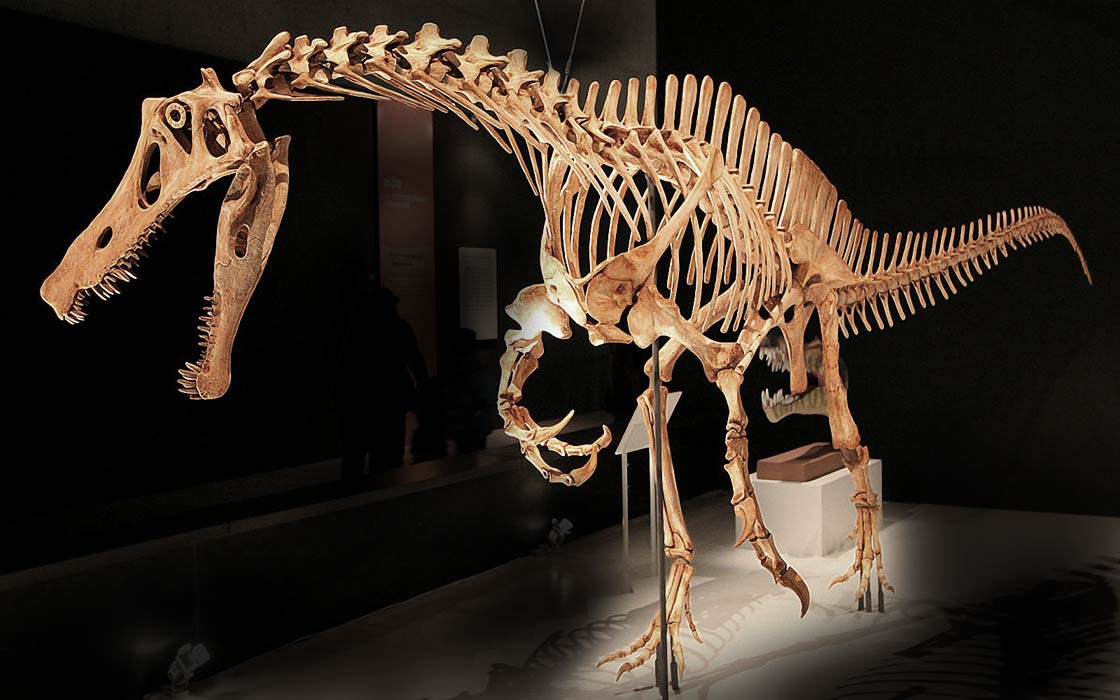Every month, 100,000 readers use the Dinosaur Database, but we receive no support from you. Developing and updating the database requires a lot of work. If you want it to remain open and be updated, please support us via the "Buy us a coffee" button available on every page or via the Support page.
Dinosaur: Irritator challengeri

| Length*: | 6.1 m | 20.0 ft |
| Weight*: | 530 kg | 1,168 lb |
*The largest known specimen
Period
Epoch: Early Cretaceous
Stage: Albian
Years: 119.5-113 Ma
Details
Status: valid
Author: Martill et al.
Year: 1996
Distribution
Area: South America
Country: Brazil
Region: Ceará
Formation: Romualdo
Description
Irritator challengeri
Irritator challengeri is a theropod dinosaur belonging to the spinosaurid family, which lived during the Early Cretaceous period, around 119.5–113 million years ago. It was discovered in the Romualdo Formation of the Araripe Basin in northeastern Brazil. The genus name, Irritator, was humorously chosen by paleontologists due to the frustration (“irritation”) caused by the plaster modifications made by fossil dealers to enhance the specimen’s value. The species name, challengeri, is a nod to Professor Challenger, a fictional character from Arthur Conan Doyle’s novel “The Lost World.” This dinosaur is known for its distinctive skull features, which suggest a piscivorous (fish-eating) diet, similar to other members of the Spinosauridae family.
Physical Characteristics
Irritator challengeri is known from a single, partial skull, which measures about 80 centimeters (31 inches) in length. The skull is elongated and narrow, with a straight snout that gradually tapers toward the tip. It had conical, non-serrated teeth, ideal for gripping slippery prey like fish. The nasal openings were positioned far back on the skull, a trait observed in other spinosaurids, which may have helped keep water out while hunting.
The preserved portions of the skull suggest that Irritator had a secondary palate, which would have reinforced the skull structure and potentially allowed it to breathe while holding prey in its jaws, similar to modern crocodiles. This feature implies that Irritator was well-adapted for hunting in aquatic environments. Its size is estimated to be around 6 to 7 meters in length, with a weight ranging from 500 to 1,000 kilograms, making it a relatively medium-sized spinosaurid.
Diet and Feeding Habits
The skull morphology of Irritator challengeri suggests a diet primarily composed of fish, aligning with other known spinosaurids. The conical, unserrated teeth and long, narrow snout would have been well-suited for catching and holding onto fish, which it likely captured with quick, sideways movements of its head. The robust secondary palate indicates that Irritator could have breathed while holding prey in its jaws, a useful adaptation for an aquatic or semi-aquatic predator.
Some studies also propose that Irritator might have had a more generalist diet, occasionally consuming small terrestrial animals or scavenging carrion. However, direct evidence, such as stomach contents or tooth marks on other dinosaur bones, has not yet been found. The positioning of the nostrils high on the skull suggests it could have hunted with its snout submerged in water, similar to how modern crocodiles hunt.

Habitat and Distribution
Fossils of Irritator challengeri have been found in the Romualdo Formation of the Araripe Basin in Brazil, a region known for its rich fossil deposits from the Early Cretaceous period. During that time, the area was characterized by a coastal environment with a mix of lagoons, rivers, and estuaries, providing an ideal habitat for a piscivorous predator. The presence of fossilized fish and other aquatic animals in the same formation supports the idea that Irritator lived in a wetland or nearshore environment where it could easily access its preferred prey.
This region would have featured a warm, tropical climate, with abundant vegetation along the waterways. The diverse fauna of the Araripe Basin, including other reptiles, fish, and pterosaurs, suggests a dynamic ecosystem where Irritator could have played a significant role as a mid-level predator, both in aquatic and possibly nearshore environments.
Behavior and Social Structure
Based on the limited fossil evidence, the behavior of Irritator challengeri can only be hypothesized. Its adaptations for piscivory suggest it was a solitary hunter, likely wading or swimming in shallow waters to catch fish. The elongated skull and conical teeth indicate it used a rapid side-to-side head movement to capture prey, similar to the hunting methods of modern crocodiles or herons.
There is no direct evidence for social behavior or pack hunting in Irritator. However, like many other spinosaurids, it may have been a solitary or opportunistic feeder, depending on the availability of prey. Its semi-aquatic adaptations suggest it could have spent significant time in or near water, possibly sunbathing or resting along riverbanks or coastal areas.
Discovery and Research
The holotype specimen of Irritator challengeri was discovered in the early 1990s and purchased by the State Museum of Natural History Stuttgart in Germany. Initially, the skull was heavily modified by fossil dealers who had added plaster to make it appear more complete, leading to considerable confusion and frustration among researchers. This led to the name Irritator. The specimen was first described scientifically by David Martill, Arthur R. I. Cruickshank, and colleagues in 1996, who recognized it as a spinosaurid based on its skull morphology.
The discovery of Irritator expanded the known range of spinosaurids to South America and contributed to the understanding of their diversity and geographic distribution. Subsequent research has focused on refining the anatomical features of the skull, understanding its ecological role, and placing it within the spinosaurid family tree. Ongoing studies continue to explore its phylogenetic relationships with other spinosaurids, like Spinosaurus aegyptiacus and Baryonyx walkeri, and its adaptations to a semi-aquatic lifestyle.
Significance and Interesting Facts
Irritator challengeri is significant for several reasons. It is one of the few spinosaurids known from South America, helping to fill the geographic and evolutionary gaps in the spinosaurid family. Its discovery revealed the presence of spinosaurids in a region where they had not previously been identified, suggesting that these specialized theropods were more widespread than once believed.
Additionally, the humorous and unusual circumstances surrounding its discovery and naming have made Irritator a memorable and often-cited example in paleontological literature. Its skull’s peculiar features, particularly its crocodile-like adaptations, provide valuable insights into the diversity of theropod diets and ecological niches during the Early Cretaceous period.
Locations
Sources
Material: Incomplete skull, teeth, partial mandibles.
References: Sales, M.A.F.; Schultz, C.L. (2017). "Spinosaur taxonomy and evolution of craniodental features: Evidence from Brazil".




